客户数据业务collec的任何信息ts on its audience. It’s an essential component of any successful marketing strategy. But as global data privacy regulations increase, and consumers become increasingly conscious of how their personal data is used, brands need to innovate new ways of gathering and using customer data.
Consumers need to feel they can trust brands and businesses need to respect customer privacy preferences. For that reason they’re turning to new ways of collecting and validating customer data.
As brands move to more ethical and value driven customer data collection methods, they’re improving data quality, driving better value exchanges, and building more authentic customer relationships. Here’s how to collect, validate, and analyze customer data to grow your retail business.
Table of contents
- What is customer data?
- Types of customer data
- Why is customer data important?
- Customer data trends
- How to collect customer data
- How to validate customer data
- How to analyze customer data
What is customer data?
Customer data includes the behavioral, demographic, and personal information businesses collect from their audience.
Brands collect customer data to better understand, communicate, and engage with target customers. Customer data makes it easier for businesses to understand what customers want from brands, the specific products they’re searching for, and how they prefer to engage.
Customer data can come from multiple sources including:
- Third-party data providers
- Social media platforms
- Website analytics tools
- Customer surveys
- Loyalty programs
Types of customer data
Customer data can be broken down into four main types. Each of these four customer data types has its own collection method and advantages to its use.
First-party data
First-party data includes all information that a brand collects directly from its audience. This might include website visitors, newsletter subscribers, and customers.
First-party is considered the most important data type because it’s gathered from a brand’s audience.
As a result, first-party data is more reliable for understanding and predicting your audience’s behavior and purchasing habits. Unlike with third- or second-party data, brands can relax, knowing that consumers know exactly who has their data.
As Megan Chen, Vice President ofEncore Consulting, says, “From a digital perspective, the more you can tap into first-party data and really understand what drives your audiences, the sooner the better, for sure.”
Brands might collect first-party data from:
- Loyalty programs
- Product recommendation quizzes
- 通讯lists
- 短信营销ob欧宝娱乐app下载地址列表
- Website analytics tools
Second-party data
Second-party data is information on a brand’s audience that it didn’t collect itself.Different from third-party data, second-party data is often collected and shared through a brand partnership.
Trusted business partners sometimes agree to share insights if it’s helpful to both sides. For example, a wedding cake baker may talk to a wedding dress designer to work out a partnership or purchase data they collected from customers who bought a wedding dress recently.
Third-party data
Third-party data is information that’s collected by an external organization that doesn’t have a direct connection with the visitor or customer.
The advantage of third-party data is that it’s usually easy to purchase large quantities of demographic information on your target audience. It can be challenging to get the same quantity of demographic data through other means of data collection.
The downside of third-party data is it’s not collected from your customers and it’s available to your competitors. So it’s debatable how relevant the data is.
Plus, as global privacy restrictions increase and consumers become more conscious of how their data is used, third-party data is declining in popularity.
Zero-party data
Zero-party data is data a customer intentionally shares with a brand.这些数据可能包括购买意图,preferences, personal qualities, and how they want the brand to interact with them.
Zero-party data is also sometimes referred to as “explicit data.” Since customers proactively share zero-party data with brands, it’s considered to be more authoritative and trustworthy than other customer data types.
Why is customer data important?
Customer data provides insights into your current customer base and target audience. Using this data, brands can make informed decisions about their current and future product offering.
Businesses can better identify customer preferences and match their expectations, using data to better shape their understanding of their customer base as a whole.
Jonathan Snow, co-founder and COO ofThe Snow Agency, says that brands collecting customer data themselves is even more important in today’s nearly cookieless world.
饼干和像素面临威胁的时代dicated in the near future,” he says, “it is more important than ever to collect data you own—first- and zero-party data—so that you know who your ideal customers are, what their interests are, and what their identifying information is so that you can remarket to them and generate lookalike audience to find more people like them.”
Snow adds that zero-party data is often the most important customer data type, but it’s not often the go-to data type.
“Zero-party data is often deprioritized by brands, but this can be the fuel your business needs to create advertising assets that resonate with new potential consumers,” he says.
Ben Parr, the co-founder ofOctane AI, an all-in-one product quiz and zero-party data platform, explains how customer data plays a vital part in the growth of any business, “Customer data is critical to the survival, frankly, of any business. Over the long term, you can’t really grow without it.
“If you don’t have information about your customers, you can’t build a relationship. It’s as if you went to parties with somebody else, but you never asked for their name or what they do or where they work or anything like that.
“And the result is that you’ll never get a friendship with them. You don’t even know how to contact them. It’s the same kind of thing. If you don’t ask those questions, you don’t have that information. You can’t do anything with that customer.
“You can’t get them to become a repeat visitor. You can’t build a relationship. You can’t build any brand affinity. And then eventually your brand dies, right? So customer data, especially zero-party, first-party data, are critical to building the relationship with customers over time.”
Customer data during the holiday season
During the holiday season, most ecommerce brands experience an uptick in traffic. Whether it’s Black Friday, Cyber Monday, or last-minute purchases on Super Saturday, shoppers are on the hunt for deals.
The holiday season is especially important for gathering more information on customers—and due to the increase in site visitors, brands can collect more customer insights.
David Rekuc, CEO ofDTCskin care brandBambu Earth, explains that even though skin care products aren’t traditionally gifted items, purchase intent goes up during the holiday season. This increase enables the brand to collect more customer data in a shorter period of time.
“More new customers are shopping, so we can pull in much more customer data. What we usually do is encourage site visitors to take our skin care quiz so we collect more customer data on their preferences. We can then store this customer data for future emails or analysis,” he says.
The holiday period also means that existing customers are much more likely to purchase. Rekuc explains that this is a great moment to present customized offers to existing customers, based on the data you’ve already collected throughout the year.
“Not only are these customers already on your list, but it’s an elevated time to purchase, so a great moment to put an offer or product recommendation email on the table,” he says. “It’s important to take into consideration something that they’ve already told you. That way, you’re able to tailor the offer and effectively take advantage of that higher purchase intent time period.”
While brands may be able to collect more customer data during the holiday season, it’s important not to let it skew results collected throughout the rest of the year.
Logan Grasby, ecommerce lead at healthy ready meal brandInspired Go, explains that customer behavior during the holiday season isn’t always representative of their actions throughout the rest of the year. Instead, it’s best to use this data for forecasts of the same time of the year.
“Just because people are acting a specific way during the holiday season doesn’t mean that’s how they’re going to act all year,” he says. “But you can collect post-purchase data from the holiday season and then use it to help forecast future holiday periods or discount events.”
Grasby adds that it’s key to compare holiday season customers to those customers acquired during other periods of the year. He says brands should ask themselves questions about these customers: “How long did they stick around after we acquired them? And how do they compare to customers that we acquire throughout the rest of the year?
“他们更有价值超过60天吗?还是他们less valuable? That’s all going to impact your decisions moving forward. The next time you run a big discount or you go into the holiday season, this customer data will impact your brand’s decisions.”
Customer data trends
Tightening data privacy regulations and privacy conscious consumers are shaping current and future customer data trends.
Cookieless marketing
规定继续使数据跟踪困难and the biggest players are slowly phasing out support for third-party cookies. Internet users are beginning to exercise their privacy rights and governments are making it easier for them.
Currently, only32% of internet usersin the US say they always accept cookies when they open a website.
For instance, in November 2021, China’sPersonal Information Protection Law产生的效应。仅仅几个月前,Brazil began issuing penalties to violators of the country’sGeneral Data Protection Law. In the US,California’s Consumer Privacy Actput data transparency into state law immediately before the pandemic. Plus, the European Union’sGeneral Data Protection Regulation (GDPR)has cost some businesses dearly infinessince its establishment in 2018.
Apple, Firefox, and Brave browsers already automatically block third-party cookies. Google Chrome, representing over 60% of search engine market share, announced in July 2021 that it willdelay third-party cookie blocking until late 2023. But that doesn’t mean brands should rely on Google’s cookies in 2022—a cookieless world is coming and ecommerce brands need to be prepared for that.
The situation isn’t any easier for mobile apps. For the past 10 years, mobile apps have relied on Apple’s Identifier for Advertiser (IDFA) to track users across other companies’ apps and websites for targeting and advertising purposes. But with Apple’s release of iOS 14.5 in April 2022, iOS app developers now must request permission to track their users beyond the app they’re using. Since opt-in rates are expected to be low, this change is expected to massively impact the entire mobile advertising system.
At the end of June 2022, Mozilla launched Firefox 102, and with it came support for the newquery parameter stripping functionalityto boost user privacy. With this announcement, there are no guarantees that brands can rely on UTM codes to track the performance of campaigns and content—and other browsers may follow the announcement.
Becoming harder to collect customer data
Given the near cookieless future, increasing privacy restrictions, and the consumer need for understanding who has their data, it’s no surprise that it’s becoming harder for brands to collect customer data.
Ben Parr, co-founder and President ofOctane AI, explains how Google Chrome’s decision to block third-party cookies will present new challenges for brands that previously relied on this data collection method.
“The change is going to fundamentally change advertising, and it’s going to fundamentally change how ad platforms work and how data tracking works,” he says.
“And it’s going to make data collection much harder. Those brands that haven’t collected any zero-party or first-party data will be left behind, while the ones that have collected first-party data will be in a much stronger position to take advantage of the changes.”
Parr adds that those brands wise enough to collect first- and zero-party data will be the ones that excel ahead of the competition.
As we’re going to have more consumers getting more ability to opt out of data tracking, and they opt out at a very high rate, the results are going to be a group of brands that are left behind and a group of brands that thrive as a result of the change,” he says.
Customers demand personalization
Customers want to see brands personalize their offering. But they’re unwilling to compromise on their data privacy.
品牌是把客户的第一手数据fill the space third-party cookies will leave. To provide more personalized offerings, brands are innovating new ways of collecting customer data.
Forty-two percent of brandsplan to offer their customers personalized product recommendations through tools like quizzes, custom mobile apps, and first-party or third-party behavioral data.
To encourage data sharing,44% of brandsalready plan to be more transparent around how they use customer information.
While consumers want personalization, they’re also more than three times more likely to abandon brands that “over-personalize,” compared to brands that don’t personalize enough.
But there’s a nuance here:44% of consumerssay they’re OK with brands they like using their personal information to deliver relevant content and offers.
Consumers are willing to share personal information with businesses that align with their identity. If businesses want access to customer data, they need to do it in a way that builds trust.
The key takeaway here is that customers want personalization, but only when it comes from brands they like and trust.
Brands build communities
One way to build trust and develop customer loyalty is by building communities. While brands look to build relationships with customers, many are turning to community building. Brand communities have been rising in popularity over the past few years—with good reason too. Communities are proven toincrease customer retention and brand awareness, and decrease customer support costs.
As Kimberly Smith, founder of DTC beauty brandMarjani, says, the effect of solid brand communities can be so strong that some brands haven’t needed to invest or explore other marketing avenues.
Some brands have yet to even explore digital marketing or paid advertising because their community is so strong,” she says. “They spend so much time [building] it that it drives the direct-to-consumer revenue.”
As a bonus, these communities are also sources of high-quality customer data. By providing value to your customers by answering product questions, enabling them to meet like-minded members, and attend online or offline events, brands can then draw on the data they’re providing.
Customers want to know how brands use their data
As consumers become increasingly conscious of data privacy regulations, they want to know exactly how brands are using their data. They’re becoming more cautious about who they share their data with. They also want to know exactly how brands use their data.
In fact,40% of consumerssay they have refused to buy from a brand because of concerns around personal data use. Plus,57% of consumerssay they’re increasingly concerned with how brands use their personal information.
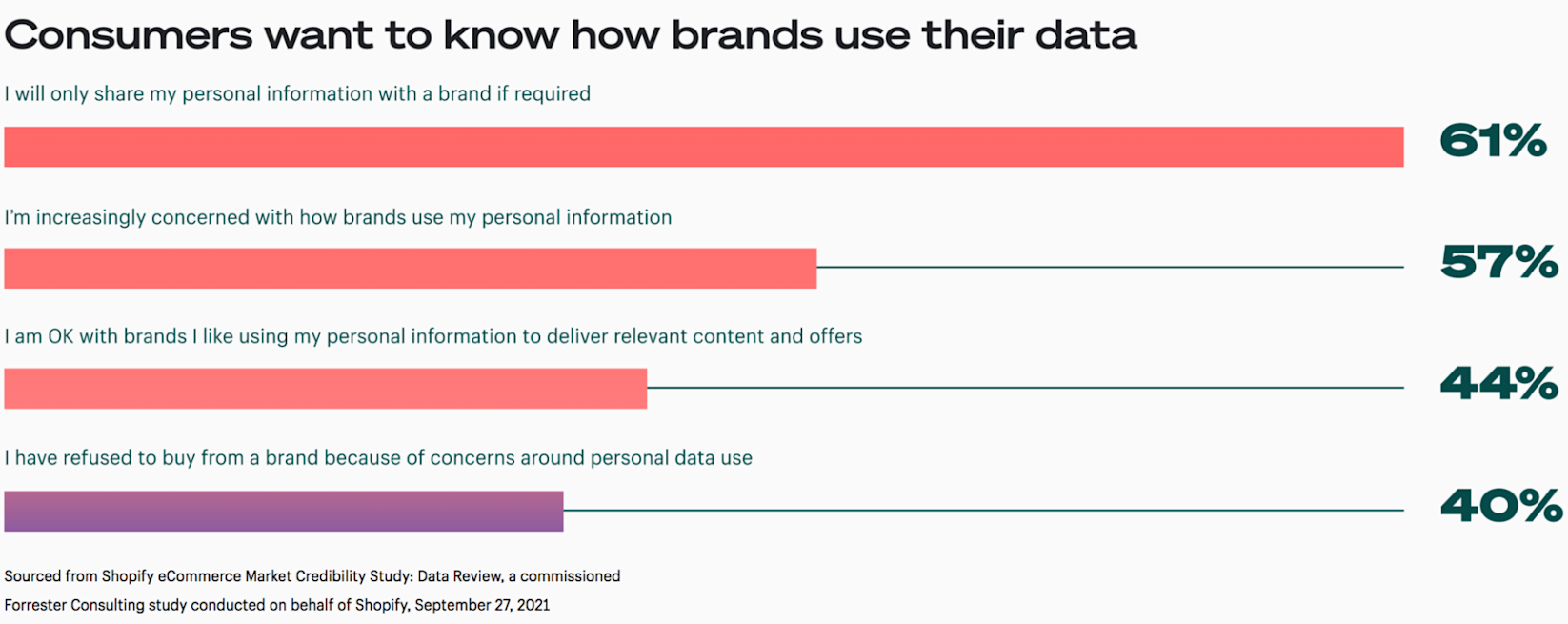
How to collect customer data
It’s no secret that successfully collecting customer data requires brands to think outside the box. Instead of depending on third-party cookies and other platforms, brands will need to harness internal resources and tune into what their customers feel comfortable with.
Here areeight ways to collect customer data.
Incentivize customers
If customers are providing you with their personal data, it makes sense to reward them. Sometimes a small incentive can go a long way in encouraging customers to part with their information.
Brands can say thank you to customers with a simple discount code or coupon. For example, beauty brand Marjani gives new customers 10% off their first order in exchange for their phone number and email address. The brand also promises access to exclusive events, deals, and content.
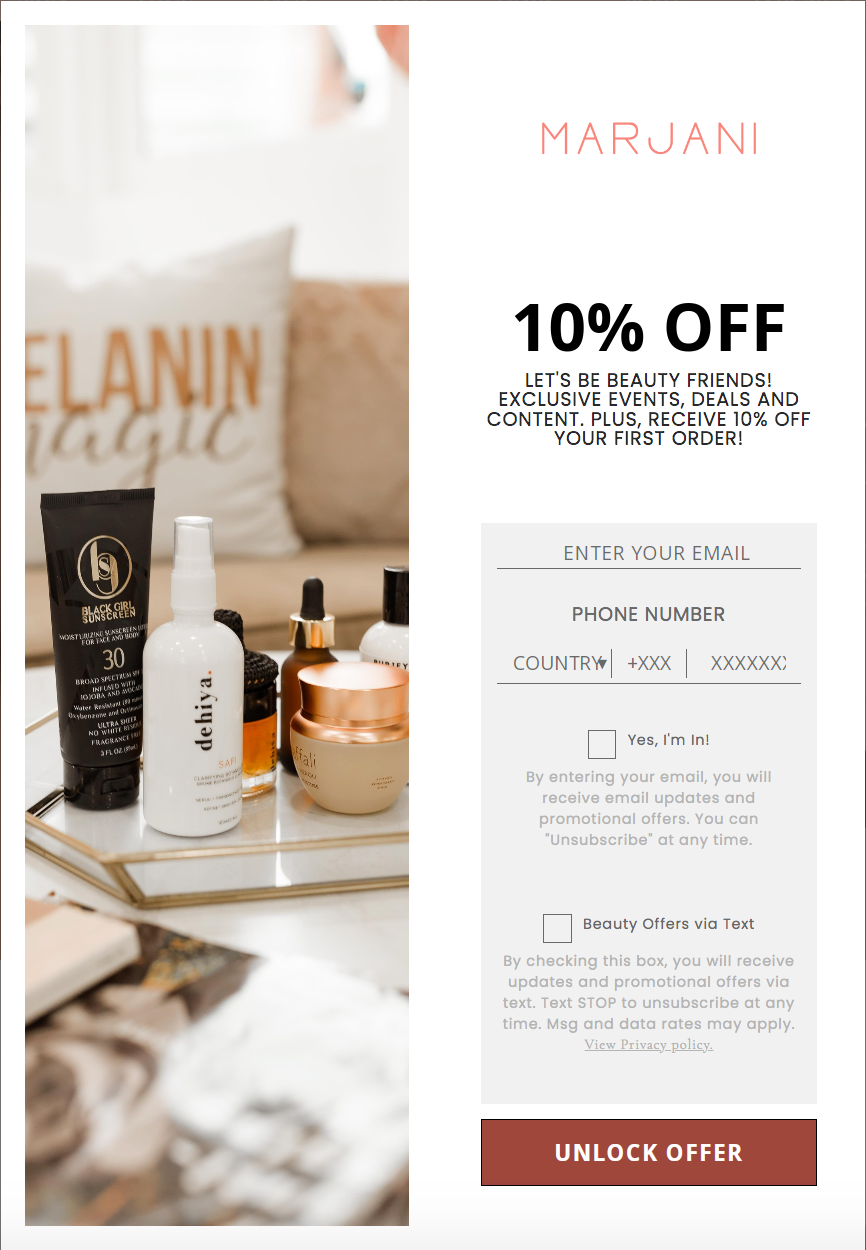
Marjani takes care to explain what customers are signing up to when they provide their data: email updates and promotional offers via text. The brand also explains how customers can opt out of these messages at a later date. This helps build trust among consumers that the brand is using their personal data responsibly.
Provide customers with real value
Brands should see customer data collection as an exchange of value. When customers provide brands with helpful personal data, brands need to be prepared to offer true value in exchange. Doing so will encourage customers to share their data as well as help build customer relationships based on trust.
Etienne Merineau, founder ofHeyday by Hootsuite, explains that brands shouldn’t take customer data for granted.
“[Brands can’t] just hoard data, they need to earn it, which is a good thing,” he says. “Because as consumers, I think we’re all willing to share our information if there’s an exchange of value, so there’s value creation. And that’s what brands need to do. That’s the simple yet complex answer.”
Product recommendation quizzes are one data collection method that provides value to customers.
Bambu Earthuses a multi-question quiz to better understand consumers’ skin care type, daily routines, and lifestyle.
In exchange for their ZIP code and email address, the customer receives a detailed breakdown of their skin type, the ingredients best suited to their needs, and some product recommendations based on their quiz results.
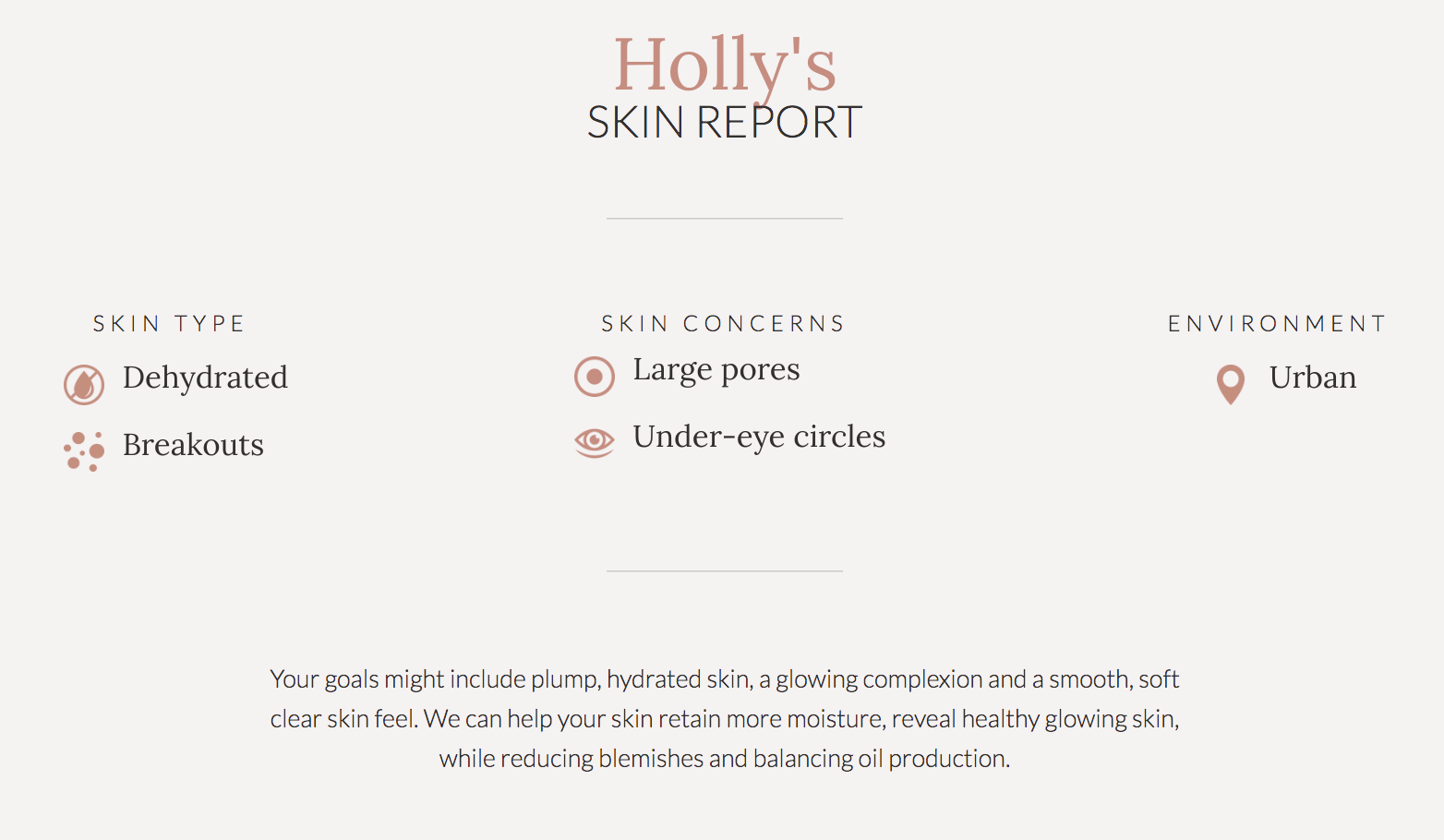
Bambu Earth’sDavid Rekucexplains how the brand’s product recommendation quiz drives real value and ultimately helps it build better customer relationships and increase sales.
“We show customers a unique bundle that matches their specific skin type and the concerns they listed,” he says.
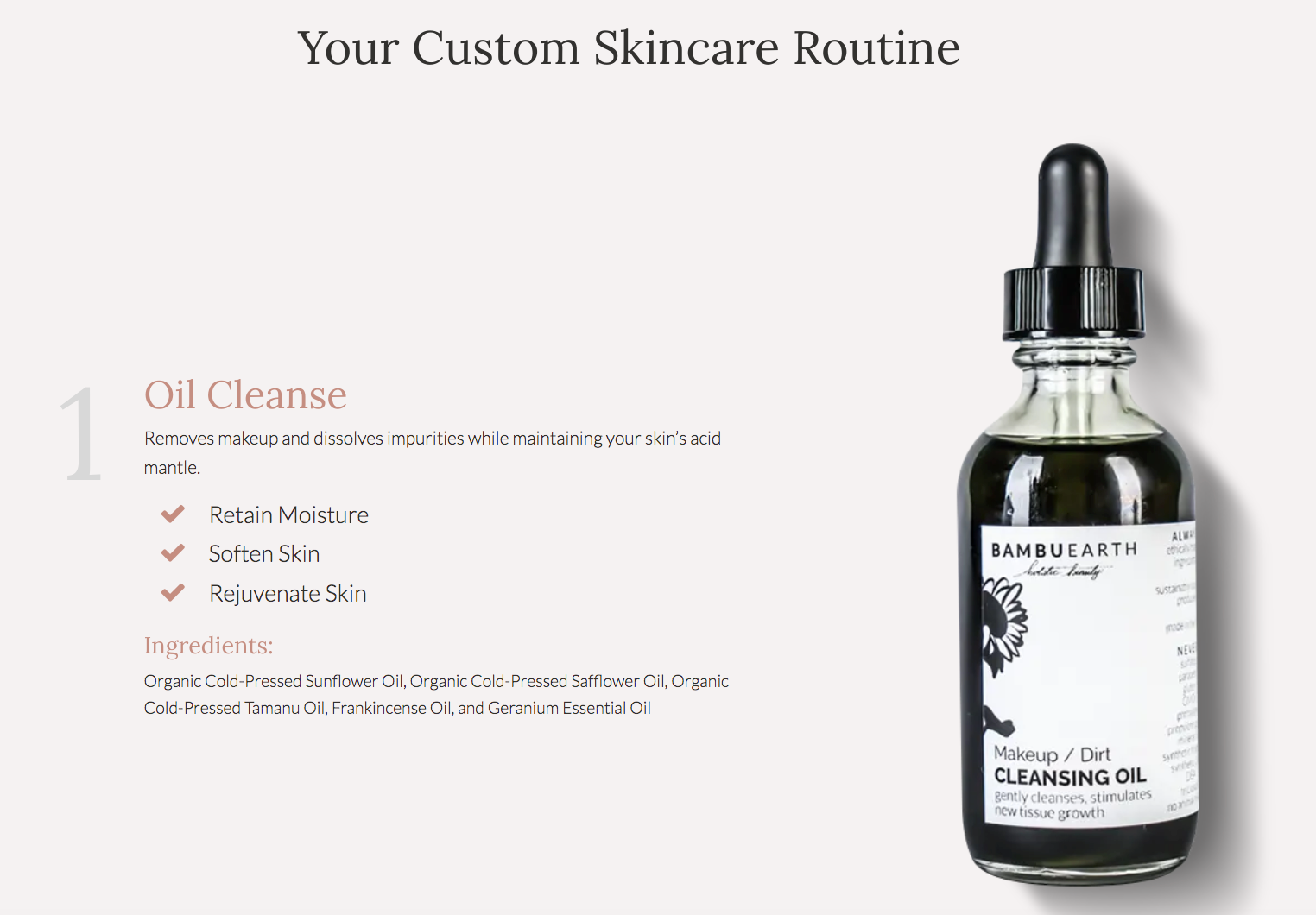
Rekuc adds that the product recommendation quiz is designed to mirror an in-person or over-the-phone interaction a potential customer could have with an expert.
“We have a full-time esthetician. If you were to sit on a phone call and have a consultation with our esthetician, she would be able to ask you similar questions and then give you a recommended routine. What the quiz does is it simulates that interaction—what might be a 20 minute interaction, it makes it a two minute interaction, entirely online, without that needed person to walk you through that.”
The best part is that Bambu Earth sees real results from customizing quiz results to each customer.
“Our personalized kit buyers are some of our best lifetime value customers, so the quiz has a direct correlation to bolster sales for the first initial order, as well as post that first order,” Rekuc says.
Lean into loyalty programs
顾客愿意加入一个忠诚总结m are among a brand’s most engaged customers. Given their proven interest and engagement, their data is highly valuable for learning more about a brand’s ideal audience.
During the registration process, brands can collect basic data points like the customer’s name, email address, and location. To gather more in-depth information about customers’ shopping preferences, lifestyle habits, and anything else that’s relevant, brands can encourage customers to share more personal information.
DTC头发care brandProsehas a customer loyalty program that offers customers perks like 15% off their orders, hair care consultations, and access to exclusive products.
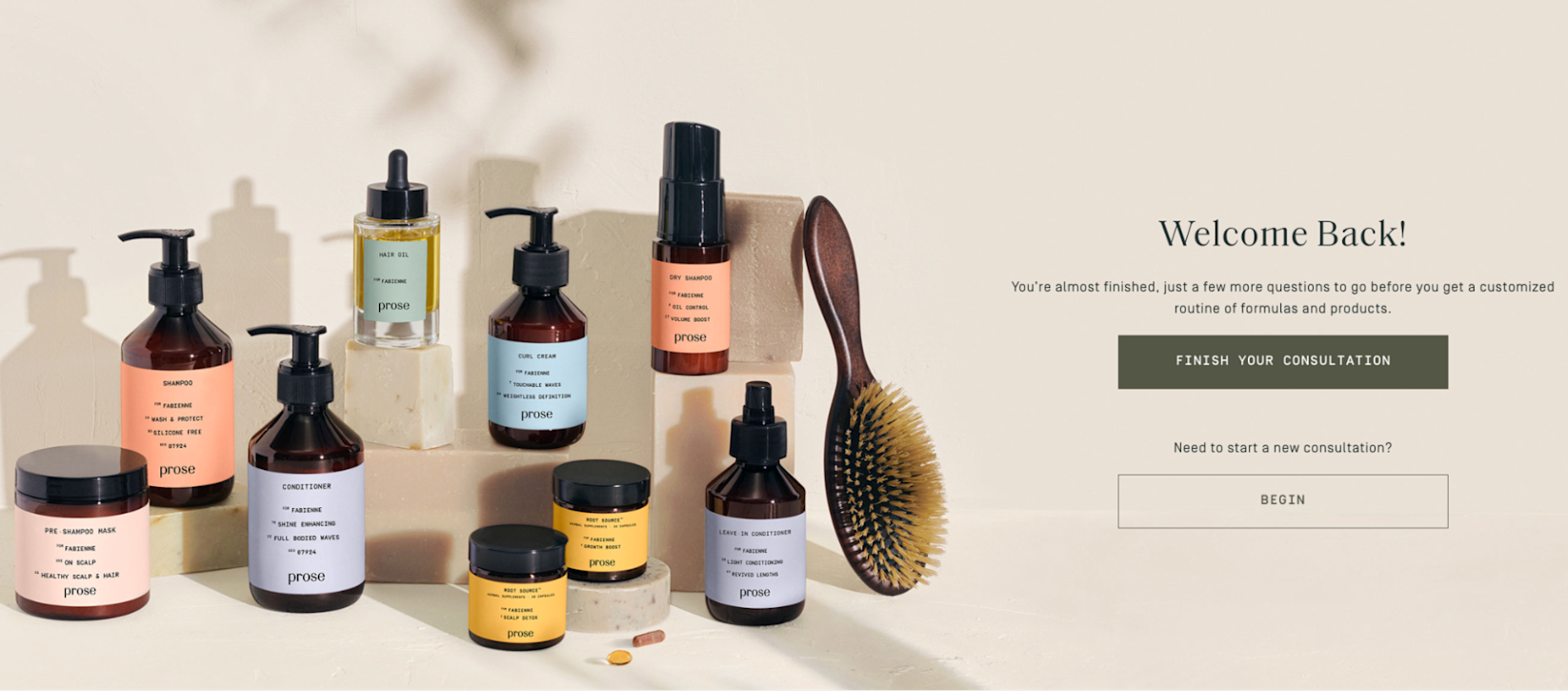
In exchange for these benefits, Prose asks customers to complete a quiz that asks them questions about their hair type, lifestyle, treatment preferences, and goals.

Customer responses to these questions help Prose get a better idea of who is shopping with the brand. Are customers new to buying specific hair care products? Do they tend to have goals other than healthier hair?
This customer data helps the brand segment its audience and create more targeted future marketing campaigns.
Don’t forget about offline interactions
It’s easy to get caught up in slicing and dicing online customer data, but offline interactions are valuable sources of customer data too.
CRM and POS systems provide information on a shopper’s purchasing history so brands can offer more personalized experiences and customized product recommendations.
This customer data can also show you which products are selling and where.
For this first-party data collection method to be effective, brands need to centralize their POS data and website data in one place. That way, when it comes to analyzing patterns and trends, it’s easy to see everything at once.
The best ecommerce platforms let you connect your customer relationship management (CRM) and enterprise resource planning (ERP) to your workflows. Shopify Plus allows you to plug in all the tools and systems you already use, so you can view performance analytics and manage automation flows across your business.
Speak with support teams and store associates
The people who know your customers the best are the ones on the ground interacting with them every day. Support teams and store associates know all about customer complaints, requests, and preferences.
Customers usually contact support teams for help tracking orders, starting an account, or complaining about a problem. Aggregating this data can highlight where to focus campaigns and help define customer profiles.
Ask customers for feedback
Surveys, questionnaires, and customer reviews provide your brand with ultra-relevant first-party data. They can highlight where customers feel their expectations are met as well as areas for improvement.
As a bonus, asking customers for feedback can help build trusting authentic relationships. When customers see your brand genuinely cares about their feedback and is willing to take it on board, they’ll feel valued and more likely to share their honest viewpoints.
DTC dental care subscription brandQuipactively asks customers for reviews to better understand their preferences. As a bonus, the brand displays the most positive reviews on its site as social proof.
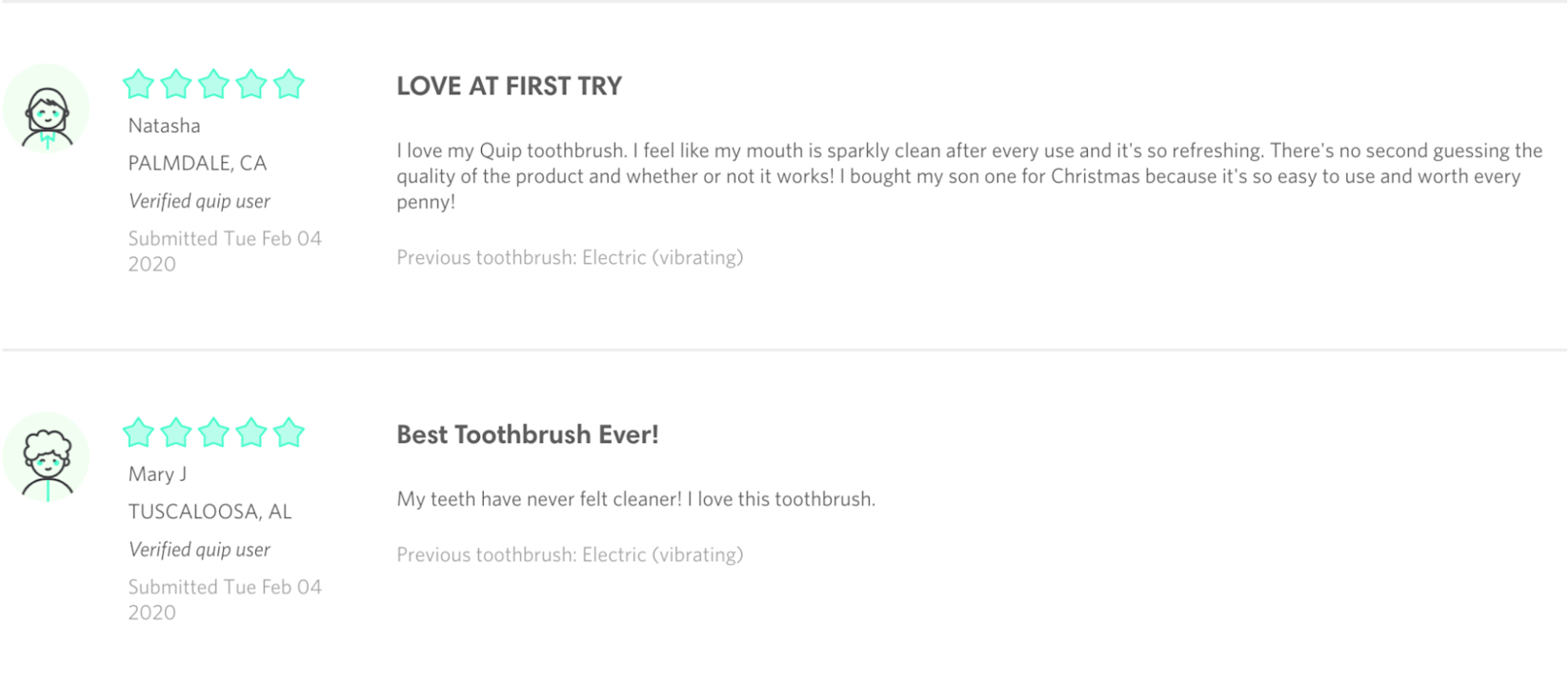
Collect customer data from different sources
While gathering customer data can seem labor intensive, it’s essential to collect it from multiple sources. That way you can build out segmented marketing campaigns that target customers at different moments in the customer journey.
David Wagoner, co-founder of ecommerce agencyP3媒体, explains that effective marketing campaigns are built from collecting varied data types from customers.
“You’ve got to be collecting as much first-party data as you possibly can to run effective marketing campaigns with your customers,” he says.“This includes running as many technical programs as possible to just collect the data quite simply. And so that’s lead capture forms, email pop-ups, SMS pop-ups, customer surveys, post-purchase questionnaires, back in stock notifications as a tool of enticement to get customer data. Again, this is just incredibly critical these days, as cookie-based tracking is going away.”
Gathering customer data through multiple collection points will give your brand as much exposure as possible to different customer profiles, preferences, and habits.
For example, DTC cookware brandGreat Jonesrequests browsers email addresses via a pop-up as soon as they arrive on the brand’s homepage. It entices visitors to share their email address in exchange for 10% off their first order.

The brand also gathers customers’ phone numbers through potline—a service that provides dinner recipe suggestions through SMS.

Tap into web analytics
With the death of third-party cookies, brands need to tap into web analytics data that they own. Using web analytics tools, brands can get customer data by:
- Tracking user behavior like which products they added to the cart
- Identifying which images and text users are most likely to hover over
- Finding out what they’re typing into the search bar and which web pages they visit the most
This customer data can then inform personalized marketing campaigns. For example, sustainable clothing brandReformationsends out playful abandoned cart reminders to encourage customers to purchase products.
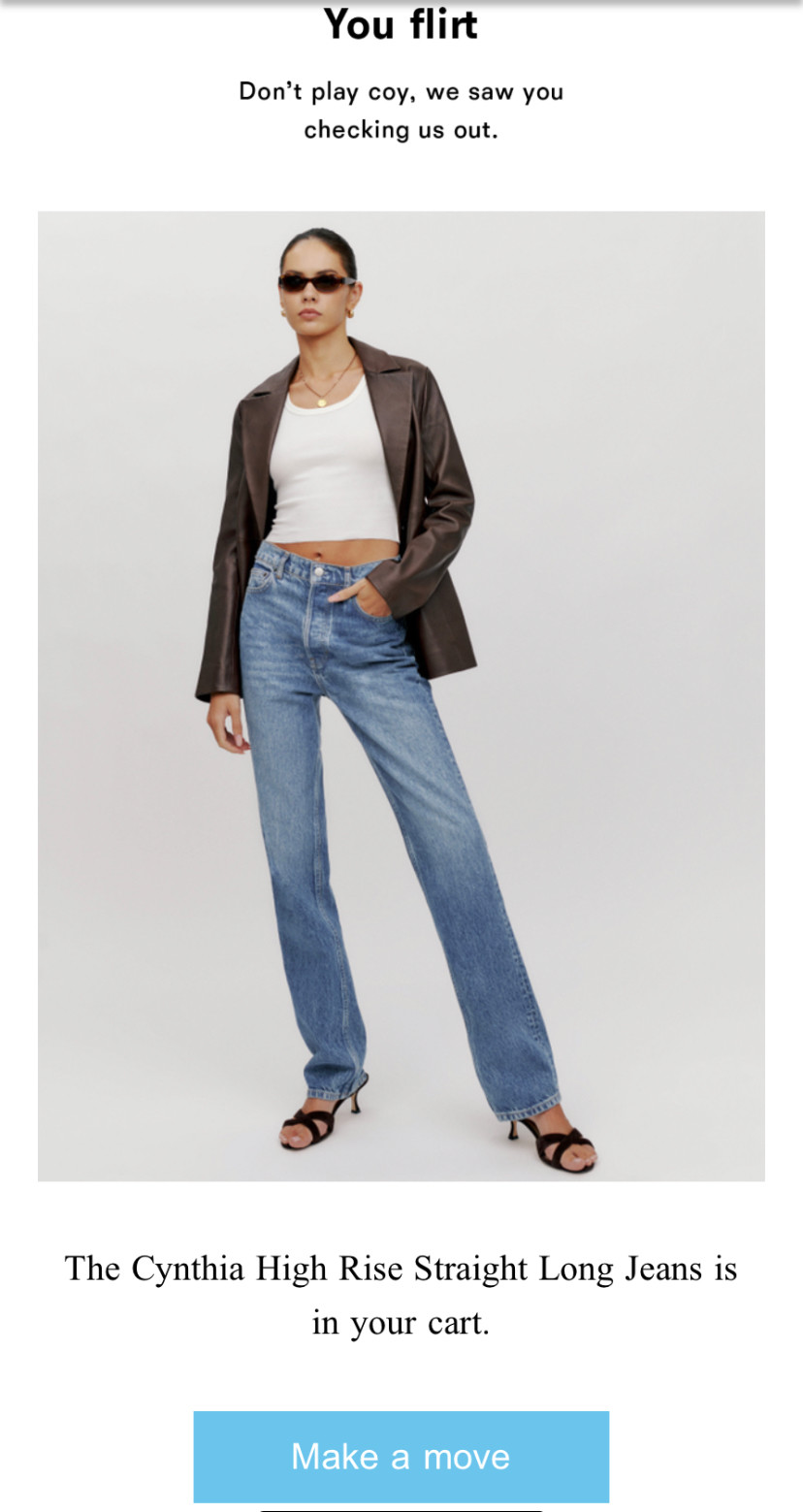
The advantage of web analytics over third-party cookies or social media analytics is that brands own the data—that means they’re in charge of its storage and usage for good.
Matt Madrigal, VP/GM of Merchant Shopping at Google, explains how the search engine supports Shopify merchants’ ownership of their customer data.
“We’ve made it easy for Shopify merchants to list all their inventory across Google services in just a few clicks,” he says. “And as they meet customers where they are, that direct relationship is something that’s owned with the consumer and the merchant themselves, really that first-party data, and consistent with privacy concerns in that regard.”
How to validate customer data
Now that you’ve put resources, time, and budget into collecting customer data, how do you know it’s worth holding on to and analyzing?
Before you use customer data to inform brand-wide decisions and upcoming marketing campaigns, take time to ensure it’s accurate.
Here are four ways to validate customer data.
Put systems in place to control data quality
Gathering high-quality customer data comes down to some level of data quality control. Brands need to consider how they can implement systems to filter out lower quality data and focus on datasets that matter.
Logan Grasby ofInspired Goexplains that setting up effective filters is essential for gathering and managing high-quality data.
“Brands have to realize that they’re going to get a lot of bad data,” he says. “Even with first-party data collection through forms or surveys, you’re not always going to get valuable information. So being able to sift through it quickly and make decisions is super important.”
Grasby explains that first-party data can be pretty hard to validate because people can ultimately submit whatever they want, but the key is to have efficient systems in place to better control the quality.
“For us, one of the ways that we act on data that we collect is by determining whether there are quality issues we have to address,” he says. “So we actually have someone who goes through that data and then pulls out the key quality issues. Having a system in place to make that process fast is important, because otherwise it would just take forever. That system is going to change, business by business.”
Perform customer data validation checks
Inaccuracies throughout your customer data can cause shifts in the entire dataset. Before you segment and analyze customer data, take time to perform a few simple data checks. That way, if you encounter any inaccuracies, you can discard the value before it skews the rest of your data.
Here are three simple data validation checks:
- Code check.Makes sure a field is selected from a valid list of values. For example, a code check can verify if a ZIP code is correct by checking it against a list of valid codes. The same concept can be applied to email addresses and phone numbers.
- Uniqueness check.Phone numbers and email addresses are unique, so they shouldn’t appear more than once in your database. A uniqueness check ensures items aren’t entered multiple times in the same database.
- Data type check.Some fields only accept data formats like numbers or letters. Any data containing special symbols would be rejected. This can help protect against spam data entries.
Ask customers questions about the data source
Don’t be afraid to ask customers more questions about the purpose of their purchase. This key detail can help you decide whether to hold onto the data or discard it.
Ben Parr ofOctane AIsuggests brands ask who customers are buying the product for.
“I always recommend asking the question if you're buying for yourself or you're buying for somebody else,” he says. “If someone is buying for somebody else, the answer to those questions are going to be relevant in a different way.”
Parr also advises that brands look out for giveaway signs that customers are lying about their data.
“If they’re answering randomly, it’s obvious. The big tell-tale sign is that they put in a fake email or a fake phone number. If they do that, then you can go and wipe that information.”
To maximize the best chance of valuable data, Parr recommends always putting the customer first and bringing them as much value as possible.
“The best way to make sure you get high-quality results is just to make sure that your quiz or surveys are really valuable to the end customer,” he says. “For example, if a customer really wants to know the skin routine they need, they're more likely to fill out the quiz accurately.”
Ask customers to double-opt in
Making customers double-opt-in for email or SMS communications isn’t just respectful of their privacy—it also preserves the quality of your customer data.
Grasby agrees that asking customers to double-opt-in not only provides reassurance that they want to receive communications from your brand, but also helps keep data inaccuracy free.
“When you're adding someone to an email list, it’s important to be sure the customer wants to receive your content,” he says. “We also always make sure to do this when it’s a list that we particularly want to keep clean.”
How to analyze customer data
Correctly analyzing customer data is what will make the difference between putting your data to work and leaving it to languish.
Here are four best practices for analyzing customer data.
Segment data
Instead of treating all customers equally, segmenting data enables brands to better target their campaigns and build more accurate customer profiles.
For example, DTC beauty brandJones Roaduses a quiz to collect data on customers’ preferred makeup shades. Based on the results, it then segments the data and uses email and text message campaigns to target smaller segments of their audience, showing preferences for each shade.
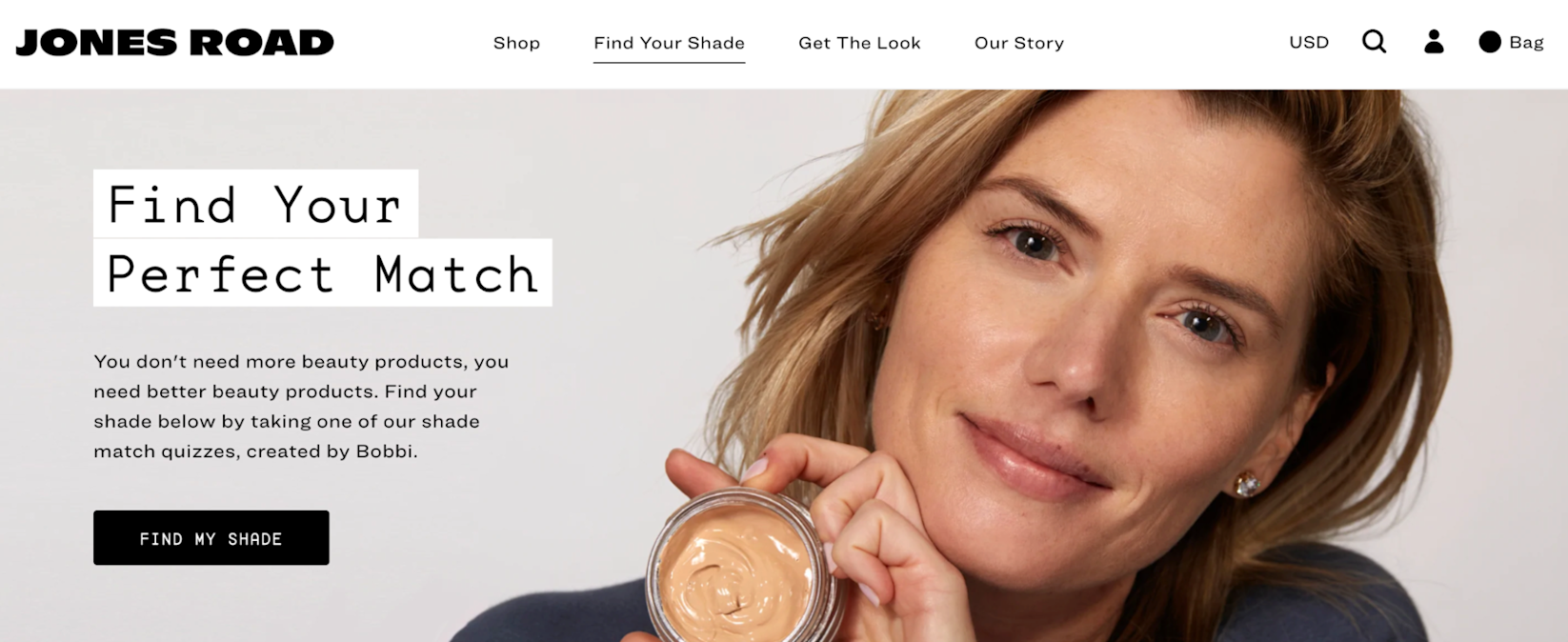
By sending customers content on the makeup shades they actually selected, the campaign will feel a lot more relevant.
Nik Sharma, founder ofSharma Brands, explains that instead of dealing with long CRM lists of data, brands should make their data more manageable to deal with by segmenting it. Doing so will also allow brands to run much more targeted ad campaigns.
“If you upload your CRM data into your paid media platforms like a pixel or Facebook, you can segment these audiences before they upload, so you have a much more targeted lookalike,” he says. “So, for example, instead of having your entire CRM list uploaded, you can segment by the lifetime value of a customer. You could also segment by the purpose that a customer purchased the product for or segment by how many star reviews somebody gave you,.
Shopify PartnerSegments Analyticshelps Shopify merchants increase repeat revenue with prebuilt segmentation and insights. The platform helps stores harness their first-party data to find opportunities like product journeys, buying cycles, and other customer behaviors for use in automated campaigns. It also lets brands sync segments across email, Facebook, and Google to build targeted campaigns.

Use data warehouses
A data warehouse is a large store of data collected from multiple sources within an organization. The collected data is then segmented and organized to power reports and later inform decisions.
Gabriel Freeman, founder ofGLF分析, explains how using a data warehouse instead of only a database lets brands better organize their data and uncover more insights.
You don’t need to be highly technical anymore to automate data into a warehouse,” he says. “And the big advantage of having it in the warehouse is now you have access to a much wider dataset. It has more columns, fields, and other things that you can analyze.”
Freeman adds that growing businesses in particular need to look at the bigger picture of their data.
“As you’re growing, I think it's really important that you look at everything rather than just if you use one of those plug-ins like, let's say, Polar Analytics. It’s great, but it only answers the questions you kind of can plug in based on the data they are giving you in the back end.
“But once you put it in the warehouse, it gives you the ability to really create any data model and ask any question you want. It unlocks more insights because there’s just more data points.”
Determine the value of customer cohorts
When organized into cohorts, customer data can be particularly helpful for making comparisons across different customer groups. Brands can analyze how a specific group of customers engaged at different moments during the customer journey.
Grasby explains how Inspired Go uses customer cohorts to predict future purchasing behavior and engagement.
“We isolate a specific group of customers based on actions they've taken, like products they've purchased over a certain period, for example, 60 days. We then compare that value with the actions of other customer groups,” he says.
“Using that insight, we might be able to say that during a customer’s first purchase, if they have a certain product in their cart, they are three times more likely to make a purchase in the same month.”
Similarly, brands offering subscriptions could use the same technique to compare different cohorts of subscribers and customers.
“We also compare the actions of our subscribers to people who are one-time purchasers,” Grasby says. “We evaluate how much more valuable our subscribers are in comparison to one-time purchases. Looking at that from a cohort basis, a month to month cohort basis is something that drives a lot of our business.”
Using Shopify PartnerReveal, brands can more easily segment audiences and discover which customers are most valuable to their business. Using RFM segmentation, it’s easier to get better customers and prevent churn. The app also lets brands monitor historical and predictive customer lifetime value and later optimize it by addressing customer segments in a personalized way.
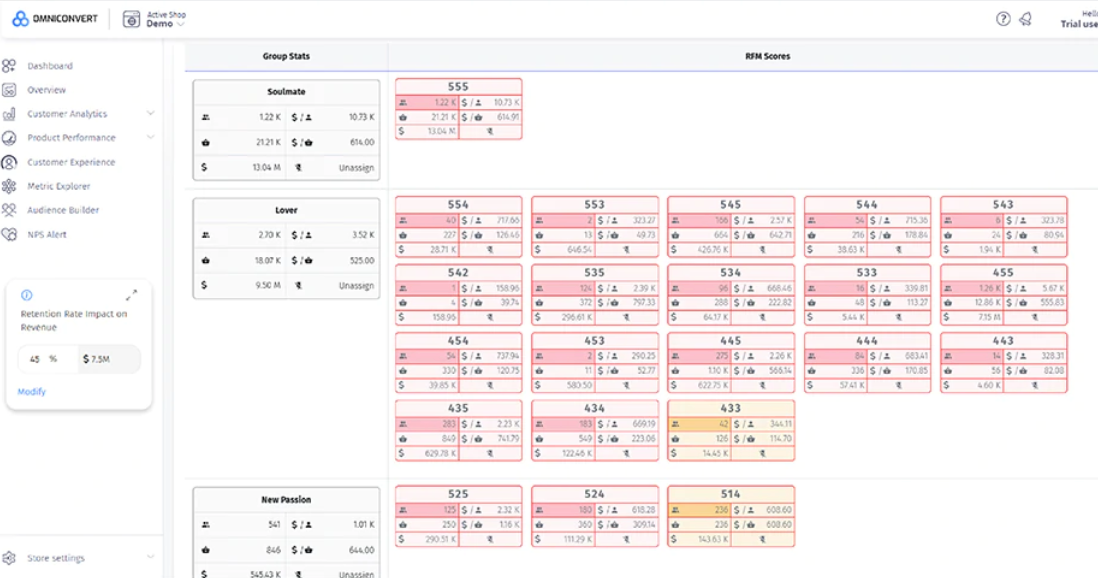
按照客户数据
The final step is to act on the collected customer data. To ensure campaigns are fresh and relevant at the time of offer, it’s key to act on customer data swiftly after collecting, segmenting, and analyzing it.
Once you’ve set up a campaign, compare how customers respond to each personalized offer. Is it something they’re interested in?
David Rekuc ofBambu Earthexplains how brands can use segmented data to compare how effective their personalized offers are at converting shoppers.
“If the customer data reveals a particular preference, send them a personalized offer, and then review how effective that personalized offer is versus a control group of customers who receive a non-personalized offer,” he says.
Rekuc adds that the quality of the customer data can be measured according to how much interest a personalized offer generates: “If you are creating data points that are valuable, you're going to see increased value from a personalized offer compared to a control offer.”
Identify future customers with Shopify Audiences
In the past, brands could rely on third-party data providers and cookies to educate them about their audience. Cut to the present and increasing privacy regulations, as well as privacy conscious customers, are signaling an end to cookie-based marketing. Brands who want to delight customers with personalized experiences will need to leverage other types of customer data to stay ahead of the curve.
To help you identify high-intent buyers, improve paid ad performance, and lower conversion costs, try usingShopify Audiences. The shared audience network can help you generate potential customers in just a few clicks.






